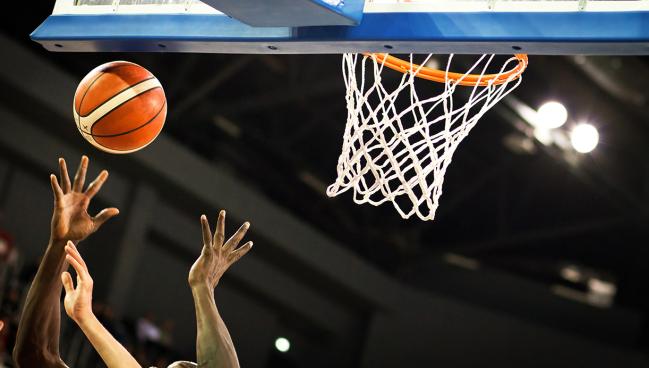Sudden Cardiac Death Declining Among NCAA Athletes
While there’s been an overall decline, males, Black athletes, and basketball players are at a much higher risk than other athletes.

The risk of sudden cardiac death among college athletes in the United States has steadily declined over the past two decades, data presented earlier this week at the American Heart Association (AHA) 2023 Scientific Sessions show.
While the overall incidence has gone down, investigators say that some athletes continue to have a higher risk of sudden cardiac death than others. Black athletes, for example, were roughly three times more likely than white to have sudden cardiac death, and male athletes were at a higher risk than female.
The highest incidence over a 4-year college career was observed in male Division I basketball players.
Senior investigator Kimberly G. Harmon, MD (University of Washington, Seattle), said this study expands on their prior research on National Collegiate Athletic Association (NCAA) athletes, but that it’s the first to suggest the rate of sudden cardiac death has declined. Among more than 2 million NCAA athletes, sudden cardiac death declined by a relative 29% for every 5-year period (incidence rate ratio 0.71; 95% CI 0.61-0.82), and overall rates fell approximately 70% during the entire study.
“We think—we don't know, because this study wasn't designed to do that—that it’s because of improved resuscitation and screening,” Harmon told TCTMD. “There's been a real focus on emergency action plans, access to the defibrillation, and recognition of sudden cardiac risk.”
Saurabh Rajpal, MD (The Ohio State University College of Medicine, Columbus), who commented on the study for TCTMD, said it’s possible the decrease in sudden cardiac death could be related to more schools putting into place action plans that include increased availability of automated external defibrillators and more training for CPR. Preparticipation screening could also be picking up inherited arrhythmias that would place young athletes at risk, he added. Those explanations, though, are only speculative, he said.
Rajpal said the most-contemporary estimates of sudden cardiac death range from one in 50,000 to 100,000 athletes. While it’s been difficult to pin down the true incidence of sudden cardiac death in young athletes, this study suggests that one in 64,000 athletes will die from sudden death in any given year.
Numerators And Denominators
For the study, which was led by Bradley Petek, MD (Oregon Health and Science University, Portland), and published in Circulation, student deaths were identified through various sources, including the NCAA resolutions list, the Parent Heart Watch database, NCAA insurance claims, and the National Center for Catastrophic Sports Injury Research database. The cause of death was determined with different methods, including autopsy and other official documents, internet searches, obituaries, and phone calls to next of kin, coaches, and more.
Harmon said the mantra around sudden cardiac death has long been that it is a “tragic but rare” event in athletes, but researchers have long struggled to get an accurate picture of its true incidence and how that might have evolved over time. Estimates have been highly variable, she said, noting that it was believed in the early 2000s to only affect one in every 200,000 to 300,000 athletes.
“The really nice thing about the NCAA is that we have a couple of different methods for trying to ascertain death, which is our numerator,” said Harmon. With a clearly defined NCAA population of athletes participating in Division I, II, and III sports, the researchers also have the denominator, one with detailed information about sex, race, and sport, which allowed them to assess incidence.
Between 2002 and 2022, there were 1,102 deaths over 9.1 million athlete-years, the most common cause being accidental. Sudden cardiac death was the most common medical cause, making up 13% of the total deaths. Of the 143 sudden cardiac deaths, 65% were identified by review of the autopsy and the most common postmortem finding was autopsy-negative sudden unexplained death (19%). The next most common finding was idiopathic LV hypertrophy/possible cardiomyopathy (17%) and hypertrophic cardiomyopathy (13%).
The overall incidence of sudden cardiac death was one per 63,682 athlete-years. As noted, male athletes had a higher incidence of sudden death than female athletes (one per 43,348 vs 164,504 athlete-years), while Black athletes had a higher incidence than white athletes (one per 26,704 vs 74,581 athlete-years). For sports with at least five sudden cardiac deaths, the highest risks were observed in basketball and football.
When a 4-year career was considered, the overall incidence of sudden cardiac death was one event per 15,921, with the highest incidence per 4 years seen in male, Division I basketball players (one per 1,462 and 1,924 for every 4-year career in white and Black players, respectively).
Adding ECG to Screening
Shelley Miyamoto, MD (University of Colorado School of Medicine/Children’s Hospital Colorado, Aurora), also believes there is an increased awareness from colleges, universities, and the NCAA about the risks of sudden cardiac death. While the decline in incidence is good news, there is still much to understand, particularly about why the risks are higher in some athletes than others, she said in a video released by the AHA.
In the NCAA, athletes are required to undergo preparticipation screening for cardiovascular disease, but the requirement doesn’t specify what that should entail. At schools with fewer resources, the physical might be done by the athlete’s family doctor, whereas other schools have the athlete screened by the team physician. It’s advised that doctors perform cardiovascular screening using the AHA’s 14-point evaluation protocol for preparticipation assessment, a protocol that doesn’t mandate the use of ECGs.
“A lot of schools over the last 10 years, particularly higher-resource schools, have included ECGs, and some have included echo in their studies, with this increased recognition that sudden cardiac death is not all that uncommon,” said Harmon. “At the University of Washington, where I'm a team physician, we've included ECG as part of our physicals since 2010.”
In a 2018 study of schools within the “Power 5” NCAA conferences, which are the most-prominent and highest-earning athletic conferences, it was shown that more than half (58%) used ECGs in addition to a history/physical examination for preparticipation screening. Athletes involved in the basketball programs at these schools were even more likely to undergo ECG and/or echocardiography screening.
“ECGs aren't super expensive, but you need to be able to read them correctly and have the resources to follow up,” said Harmon. “But if you have the resources available to do ECG screening, I think it's clear that this is the best way to screen. With the history and physical, you're not going to find a lot of things. If people really want to screen, they should be using the ECG. I think the evidence supports that.”
In many European countries, a 12-lead ECG is required to participate in competition, a practice endorsed by the International Olympic Committee.
Harmon pointed out that sudden cardiac death occurred with exertion in just 50% of cases (event within 1 hour of stopping exercise).
“You're much more likely to survive if you have your sudden cardiac arrest with an athletic trainer there, someone who has witnessed the event and can get you treated,” she said. “But if you have an arrest while you're sleeping, that's not really going to help. That’s why I think it really needs to be a two-pronged approach with both the best screening we can do and then also making sure we have secondary prevention in terms of an emergency action plan should an arrest occur.”
In an editorial accompanying the study, Domenico Corrado, MD, PhD, and Alessandro Zorzi, MD, PhD (University of Padua, Italy), say that one of the limitations of the study is that there are no data on early detection/management of cardiac diseases picked up with preparticipation screening and the number of resuscitated arrests. As such, one can only speculate about the reasons for the declining incidence.
Nonetheless, the paper “provides important data on the decreasing trends of sudden cardiac death in NCAA athletes that overlap with those previously reported on the other side of the ocean,” they write.
Michael O’Riordan is the Managing Editor for TCTMD. He completed his undergraduate degrees at Queen’s University in Kingston, ON, and…
Read Full BioSources
Petek BJ, Churchill TW, Moulson N, et al. Sudden cardiac death in National Collegiate Athletic Association athletes: a 20-year study. Circulation. 2023;Epub ahead of print.
Corrado D, Zorzi A. Declining risk of sudden cardiac death in young athletes. Circulation. 2023;Epub ahead of print.
Disclosures
- The authors and editorialists report no relevant conflicts of interest.





Comments